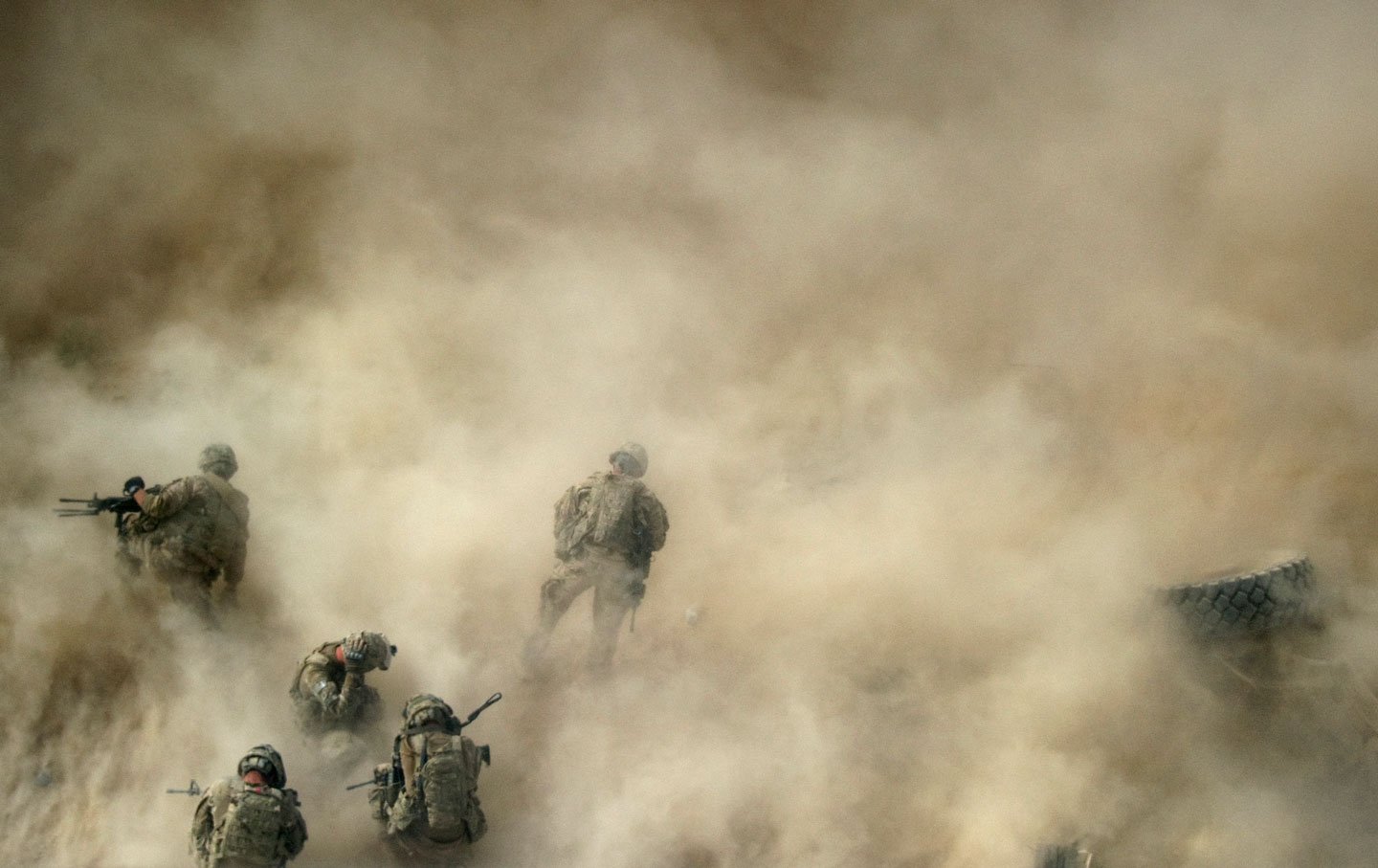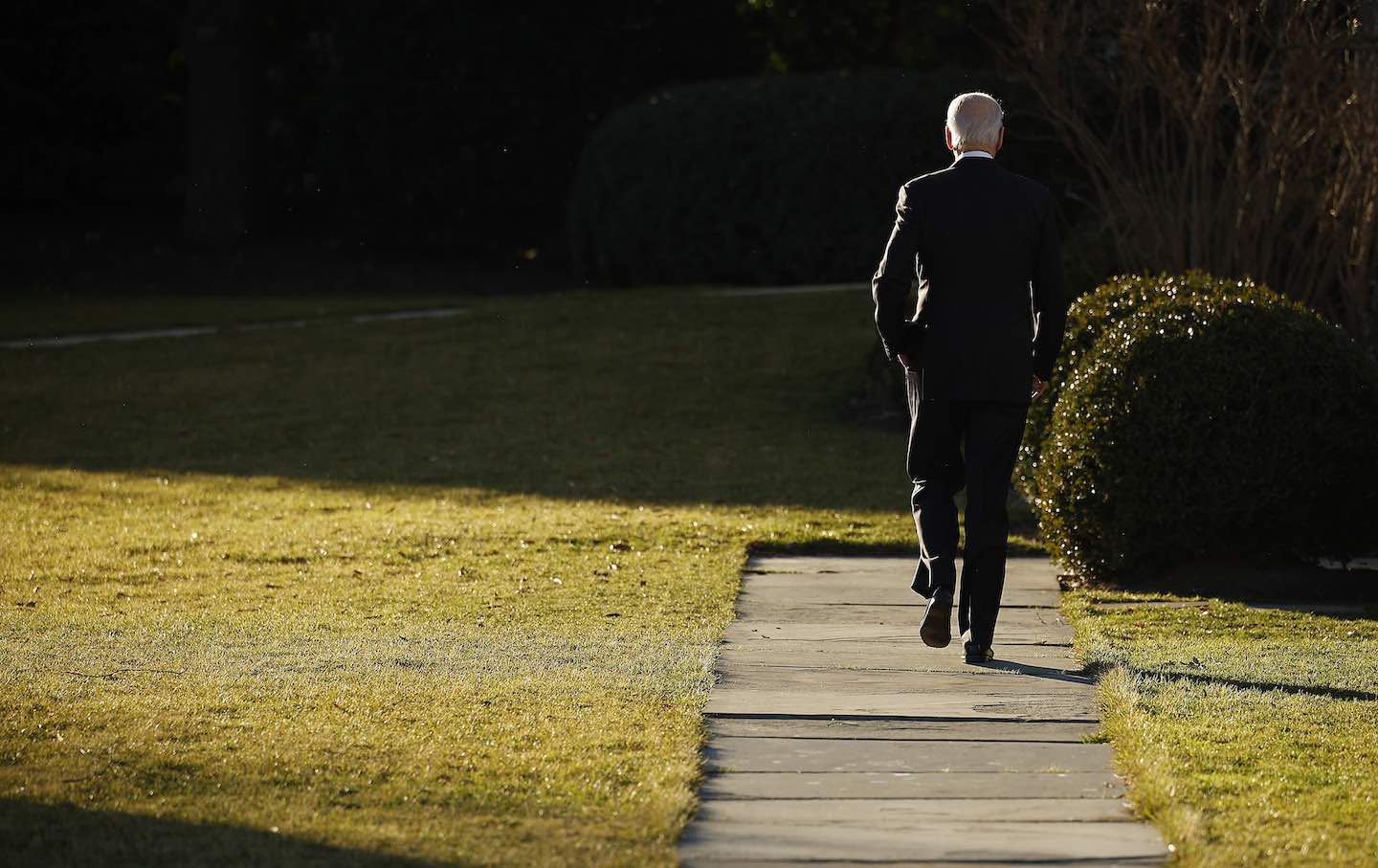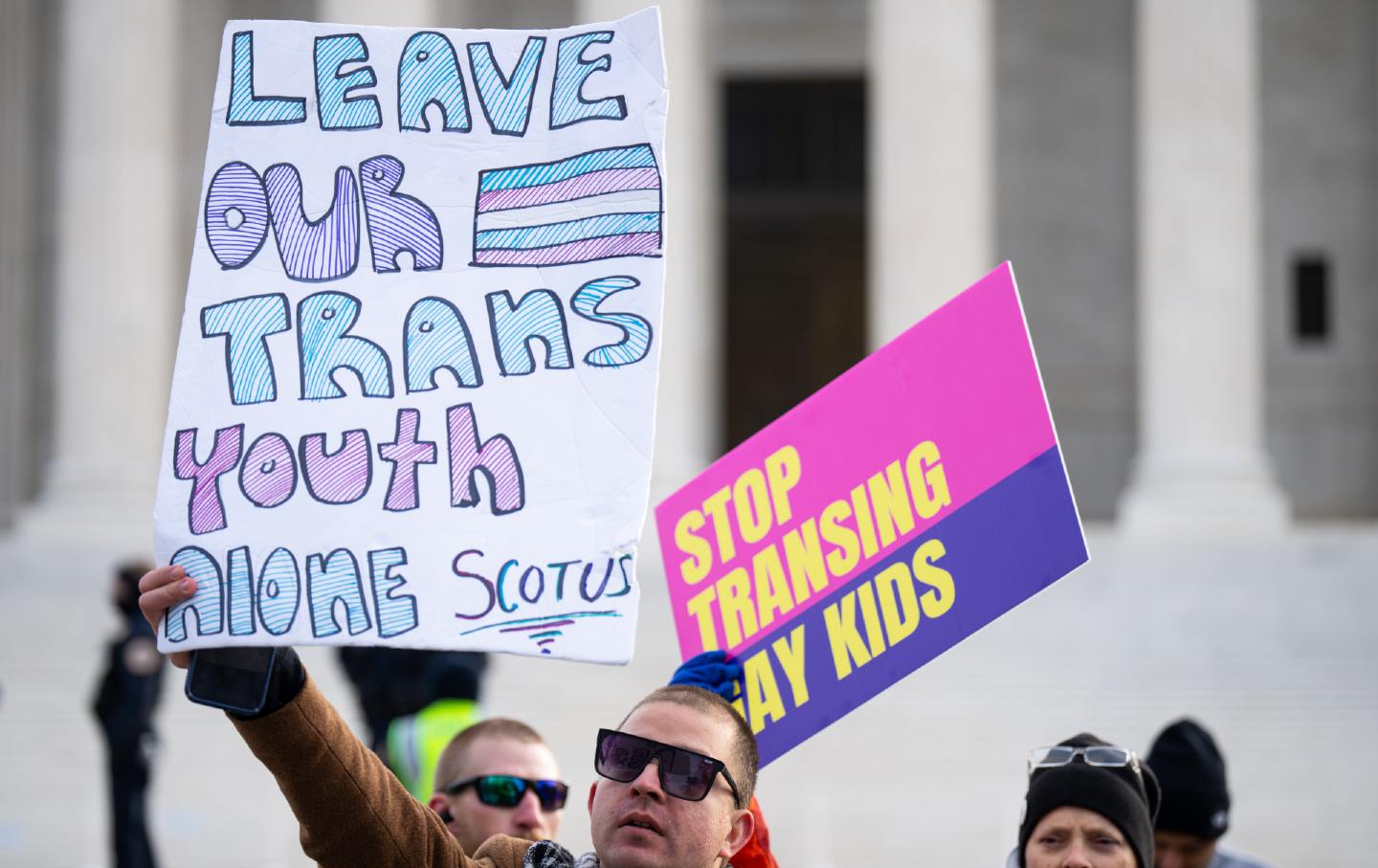The US Military Is Still Not Taking Suicide Prevention Seriously
The unanticipated toll of suicides by troops and veterans has become another Pentagon failure.

US soldiers after an IED explosion in Afghanistan.
(Johannes Eisele / AFP via Getty Images)
This article originally appeared at TomDispatch.com. To stay on top of important articles like these, sign up to receive the latest updates from TomDispatch.com.
At the end of the last century, hoping to drive the United States from Saudi Arabia, the home of Islam’s holiest sites, Al Qaeda leader Osama bin Laden sought to draw in the American military. He reportedly wanted to “bring the Americans into a fight on Muslim soil,” provoking savage asymmetric conflicts that would send home a stream of “wooden boxes and coffins” and weaken American resolve. “This is when you will leave,” he predicted.
After the 9/11 attacks, Washington took the bait, launching interventions across the Greater Middle East and Africa. What followed was a slew of sputtering counterterrorism failures and stalemates in places ranging from Niger and Burkina Faso to Somalia and Yemen, a dismal loss, after 20 years, in Afghanistan, and a costly fiasco in Iraq. And just as bin Laden predicted, those conflicts led to discontent in the United States. Americans finally turned against the war in Afghanistan after 10 years of fighting there, while it took only a little more than a year for the public to conclude that the Iraq war wasn’t worth the cost. Still, those conflicts dragged on. To date, more than 7,000 US troops have died fighting the Taliban, Al Qaeda, the Islamic State, and other militant groups.
As lethal as those Islamist fighters have been, however, another “enemy” has proven far more deadly for American forces: themselves. A recent Pentagon study found suicide to be the leading cause of death among active-duty US Army personnel. Out of 2,530 soldiers who died between 2014 and 2019 from causes ranging from car crashes to drug overdoses to cancer, 35 percent—883 troops—took their own lives. Just 96 soldiers died in combat during those same six years.
Those military findings bolster other recent investigations. The journalism nonprofit Voice of San Diego found, for example, that young men in the military are more likely to take their own lives than their civilian peers. The suicide rate for American soldiers has, in fact, risen steadily since the Army began tracking it 20 years ago.
Last year, the medical journal JAMA Neurology reported that the suicide rate among US veterans was 31.7 per 100,000—57 percent greater than that of non-veterans. And that followed a 2021 study by Brown University’s Costs of War Project which found that, compared to those who died in combat, at least four times as many active-duty military personnel and post-9/11 war veterans—an estimated 30,177 of them—had killed themselves.
“High suicide rates mark the failure of the U.S. government and U.S. society to manage the mental health costs of our current conflicts,” wrote Thomas Howard Suitt, author of the Costs of War report—where he writes further on, “The U.S. government’s inability to address the suicide crisis is a significant cost of the U.S. post-9/11 wars, and the result is a mental health crisis among our veterans and service members with significant long-term consequences.”
Military Shocked (Shocked!) by a Rise in Suicides
In June, a New York Times front-page investigation found that at least a dozen Navy SEALs had died by suicide in the last 10 years, either while on active duty or shortly after leaving military service. Thanks to an effort by the families of those deceased special operators, eight of their brains were delivered to a specialized Defense Department brain trauma laboratory in Maryland. Researchers there discovered blast damage in every one of them—a particular pattern only seen in people exposed repeatedly to blast waves like SEALs endure from weapons fired in years of training and war-zone deployments as well as explosions encountered in combat.
The Navy claimed that it hadn’t been informed of the lab’s findings until the Times contacted them. A Navy officer with ties to SEAL leadership expressed shock to reporter Dave Philipps. “That’s the problem,” said that anonymous officer. “We are trying to understand this issue, but so often the information never reaches us.”
None of it should, however, have been surprising.
After all, while writing for the Times in 2020, I revealed the existence of an unpublished internal study, commissioned by Special Operations Command (SOCOM), on the suicides of Special Operations forces (SOF). Conducted by the American Association of Suicidology, one of the nation’s oldest suicide-prevention organizations, and completed sometime after January 2017, the undated 46-page report put together the findings of 29 “psychological autopsies,” including detailed interviews with 81 next-of-kin and close friends of commandos who had killed themselves between 2012 and 2015.
That study told the military to better track and monitor data on the suicides of its elite troops. “Further research and an improved data surveillance system are needed in order to better understand the risk and protective factors for suicide among SOF members. Further research and a comprehensive data system is needed to monitor the demographics and characteristics of SOF members who die by suicide,” the researchers advised. “Additionally, the data emerging from this study has highlighted the need for research to better understand the factors associated with SOF suicides.”
Quite obviously, it never happened.
The brain trauma suffered by SEALs and the suicides that followed should not have been a shock. A 2022 study in Military Medicine found Special Operations forces were at increased risk for traumatic brain injury (TBI), when compared with conventional troops. The 2023 JAMA Neurology study similarly found that veterans with TBI had suicide rates 56 percent higher than veterans without it and three times higher than the US adult population. And a Harvard study, funded by SOCOM and published in April, discovered an association between blast exposure and compromised brain function in active-duty commandos. The greater the exposure, the researchers found, the more health problems were reported.
Studies on the Shelf
Over the last two decades, the Defense Department has, in fact, spent millions of dollars on suicide prevention research. According to the recent Pentagon study of soldiers’ deaths at their own hands, the “Army implements various initiatives that evaluate, identify, and track high-risk individuals for suicidal behavior and other adverse outcomes.” Unfortunately (though Osama bin Laden would undoubtedly have been pleased), the military has a history of not taking suicide prevention seriously.
While the Navy, for example, officially mandated that a suicide hotline for veterans must be accessible from the homepage of every Navy website, an internal audit found that most of the pages reviewed were not in compliance. In fact, according to a 2022 investigation by The Intercept, the audit showed that 62 percent of the 58 Navy homepages did not comply with that service’s regulations for how to display the link to the Veterans Crisis Line.
The New York Times recently investigated the death of Army Specialist Austin Valley and discovered gross suicide prevention deficiencies. Having just arrived at an Army base in Poland from Fort Riley, Kansas, Valley texted his parents, “Hey mom and dad I love you it was never your fault,” before taking his own life. The Times found that “mental-health care providers in the Army are beholden to brigade leadership and often fail to act in the best interest of soldiers.” There are, for example, only about 20 mental-health counselors available to care for the more than 12,000 soldiers at Fort Riley, according to the Times. As a result, soldiers like Valley can wait weeks or even months for care.
The Army claims it’s working to eliminate the stigma surrounding mental health support, but the Times found that “unit leadership often undermines some of its most basic safety protocols.” This is a long-running issue in the military. The study of Special Operations suicides that I revealed in the Times found that suicide prevention training was seen as a “check in the box.” Special operators believed their careers would be negatively impacted if they sought treatment.
Last year, a Pentagon suicide-prevention committee called attention to lax rules on firearms, high operational tempos, and the poor quality of life on military bases as potential problems for the mental health of troops. M. David Rudd, a clinical psychologist and the director of the National Center for Veterans Studies at the University of Memphis, told to the Times that the Pentagon report echoed many other analyses produced since 2008. “My expectation,” he concluded, “is that this study will sit on a shelf just like all the others, unimplemented.”
Bin Laden’s Triumph
On May 2, 2011, Navy SEALs attacked a residential compound in Pakistan and gunned down Osama bin Laden. “For us to be able to definitively say, ‘We got the man who caused thousands of deaths here in the United States and who had been the rallying point for a violent extremist jihad around the world’ was something that I think all of us were profoundly grateful to be a part of,” President Barack Obama commented afterward. In reality, the deaths “here in the United States” have never ended. And the war that bin Laden kicked off in 2001—a global conflict that still grinds on today—ushered in an era in which SEALs, soldiers, and other military personnel have continued to die by their own hands at an escalating rate.
Popular
“swipe left below to view more authors”Swipe →The suicides of U.S. military personnel have been blamed on a panoply of reasons, including military culture, ready access to firearms, high exposure to trauma, excessive stress, the rise of improvised explosive devices, repeated head trauma, an increase in traumatic brain injuries, the Global War on Terror’s protracted length, and even the American public’s disinterest in their country’s post-9/11 wars.
During 20-plus years of armed interventions by the country that still prides itself on being the Earth’s sole superpower, U.S. military missions have been repeatedly upended across South Asia, the Middle East, and Africa including a sputtering stalemate in Somalia, an intervention-turned-blowback-engine in Libya, and outright implosions in Afghanistan and Iraq. While the peoples of those countries have suffered the most, US troops have also been caught in that maelstrom of America’s making.
Bin Laden’s dream of luring American troops into a meat-grinder war on “Muslim soil” never quite came to pass. Compared to previous conflicts like the Second World War, Korean, and Vietnam wars, US battlefield casualties in the Greater Middle East and Africa have been relatively modest. But bin Laden’s prediction of “wooden boxes and coffins” filled with the “bodies of American troops” nonetheless came true in its own fashion.
“This Department’s most precious resource is our people. Therefore, we must spare no effort in working to eliminate suicide within our ranks,” wrote Secretary of Defense Lloyd Austin in a public memo released last year. “One loss to suicide is too many.” But as with its post-9/11 wars and interventions, the US military’s effort to stem suicides has come up distinctly short. And like the losses, stalemates, and fiascos of that grim war on terror, the fallout has been more suffering and death. Bin Laden is, of course, long dead, but the post-9/11 parade of US corpses continues. The unanticipated toll of suicides by troops and veterans—four times the number of war-on-terror battlefield deaths—has become another Pentagon failure and bin Laden’s enduring triumph.
More from The Nation

My Dystopian Novel Predicted Trump 2.0 My Dystopian Novel Predicted Trump 2.0
SOLIS was meant to serve as a warning of what could come. With Trump’s reelection, it should serve as a blueprint for the bravery and activism needed to fight back.

President Biden Should Issue a Blanket Pardon of Undocumented Immigrants President Biden Should Issue a Blanket Pardon of Undocumented Immigrants
Protecting Trump’s enemies from prosecution just reinforces the idea of politics as retribution. Instead, Democrats should be defending his most vulnerable targets.

The Supreme Court’s Hearing on Trans Rights Was Bigotry Masquerading as Law The Supreme Court’s Hearing on Trans Rights Was Bigotry Masquerading as Law
The conservative majority spent much of the oral arguments for US v. Skrmetti trying to erase the trans community.

Will There Be a Bird Flu Epidemic Under Trump? Will There Be a Bird Flu Epidemic Under Trump?
H5N1 currently poses a real threat for human transmission. Meanwhile, Trump’s picks for public health roles don’t bode well for vaccination.

Trans Medicine’s “Merchants of Doubt” Trans Medicine’s “Merchants of Doubt”
There is plenty of uncertainty involved in gender-affirming care—as in most aspects of medicine. But the groups behind the Tennessee ban aren’t driven by science—or patient care.

Donald Trump’s Second Administration Will Be As Women-Hating as Ever Donald Trump’s Second Administration Will Be As Women-Hating as Ever
"Your body, my choice" is only the beginning.


